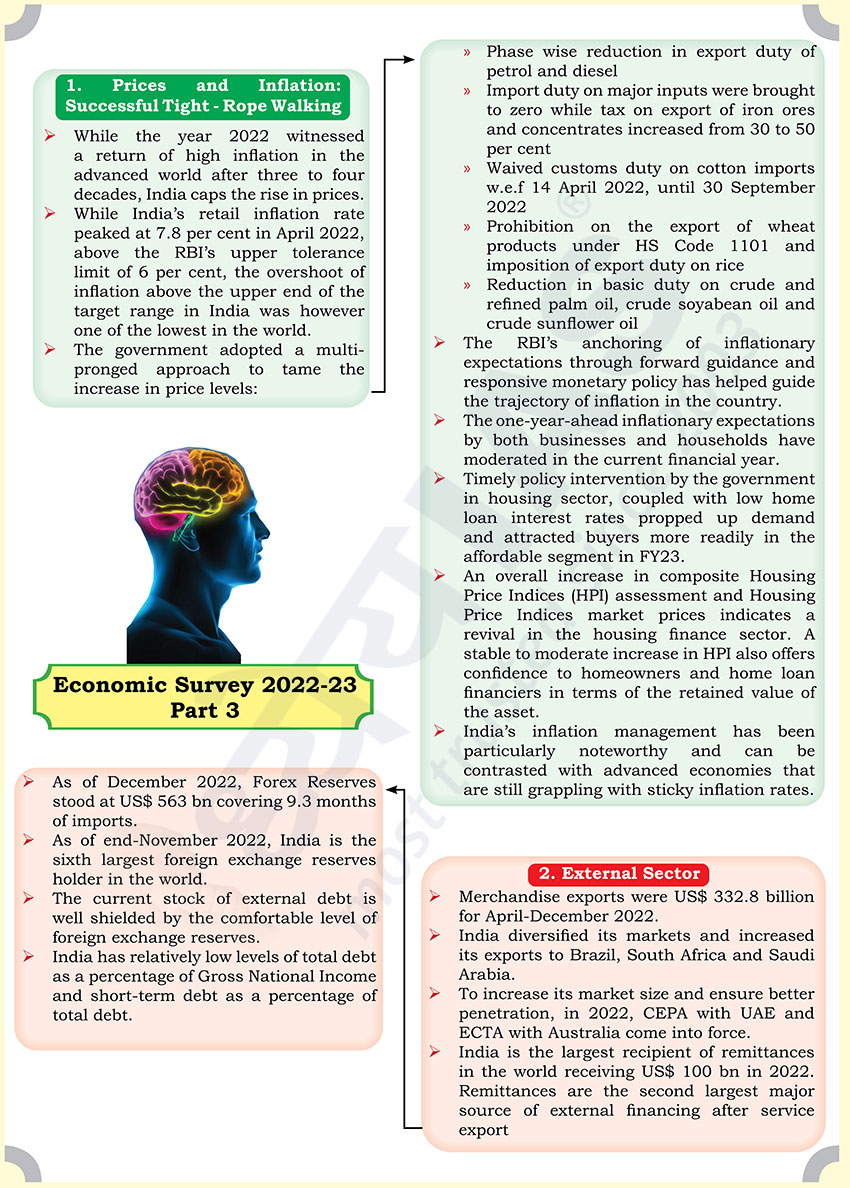Brain-booster /
27 Feb 2023
Brain Booster for UPSC & State PCS Examination (Topic: Economic Survey 2022-23 - Part 3)

Prices and Inflation: Successful Tight - Rope Walking
- While the year 2022 witnessed a return of high inflation in the advanced
world after three to four decades, India caps the rise in prices.
- While India’s retail inflation rate peaked at 7.8 per cent in April
2022, above the RBI’s upper tolerance limit of 6 per cent, the overshoot of
inflation above the upper end of the target range in India was however one
of the lowest in the world.
- The government adopted a multipronged approach to tame the increase in
price levels:
- Phase wise reduction in export duty of petrol and diesel
- Import duty on major inputs were brought to zero while tax on export
of iron ores and concentrates increased from 30 to 50 per cent
- Waived customs duty on cotton imports w.e.f 14 April 2022, until 30
September 2022
- Prohibition on the export of wheat products under HS Code 1101 and
imposition of export duty on rice
- Reduction in basic duty on crude and refined palm oil, crude
soyabean oil and crude sunflower oil
- The RBI’s anchoring of inflationary expectations through forward
guidance and responsive monetary policy has helped guide the trajectory of
inflation in the country.
- The one-year-ahead inflationary expectations by both businesses and
households have moderated in the current financial year.
- Timely policy intervention by the government in housing sector, coupled
with low home loan interest rates propped up demand and attracted buyers
more readily in the affordable segment in FY23.
- An overall increase in composite Housing Price Indices (HPI) assessment
and Housing Price Indices market prices indicates a revival in the housing
finance sector. A stable to moderate increase in HPI also offers
confidence to homeowners and home loan financiers in terms of the retained
value of the asset.
- India’s inflation management has been particularly noteworthy and can be
contrasted with advanced economies that are still grappling with sticky
inflation rates.
External Sector
- Merchandise exports were US$ 332.8 billion for April-December 2022.
- India diversified its markets and increased its exports to Brazil, South
Africa and Saudi Arabia.
- To increase its market size and ensure better penetration, in 2022, CEPA
with UAE and ECTA with Australia come into force.
- India is the largest recipient of remittances in the world receiving US$
100 bn in 2022. Remittances are the second largest major source of external
financing after service export
- As of December 2022, Forex Reserves stood at US$ 563 bn covering 9.3
months of imports.
- As of end-November 2022, India is the sixth largest foreign exchange
reserves holder in the world.
- The current stock of external debt is well shielded by the comfortable
level of foreign exchange reserves.
- India has relatively low levels of total debt as a percentage of Gross
National Income and short-term debt as a percentage of total debt.








